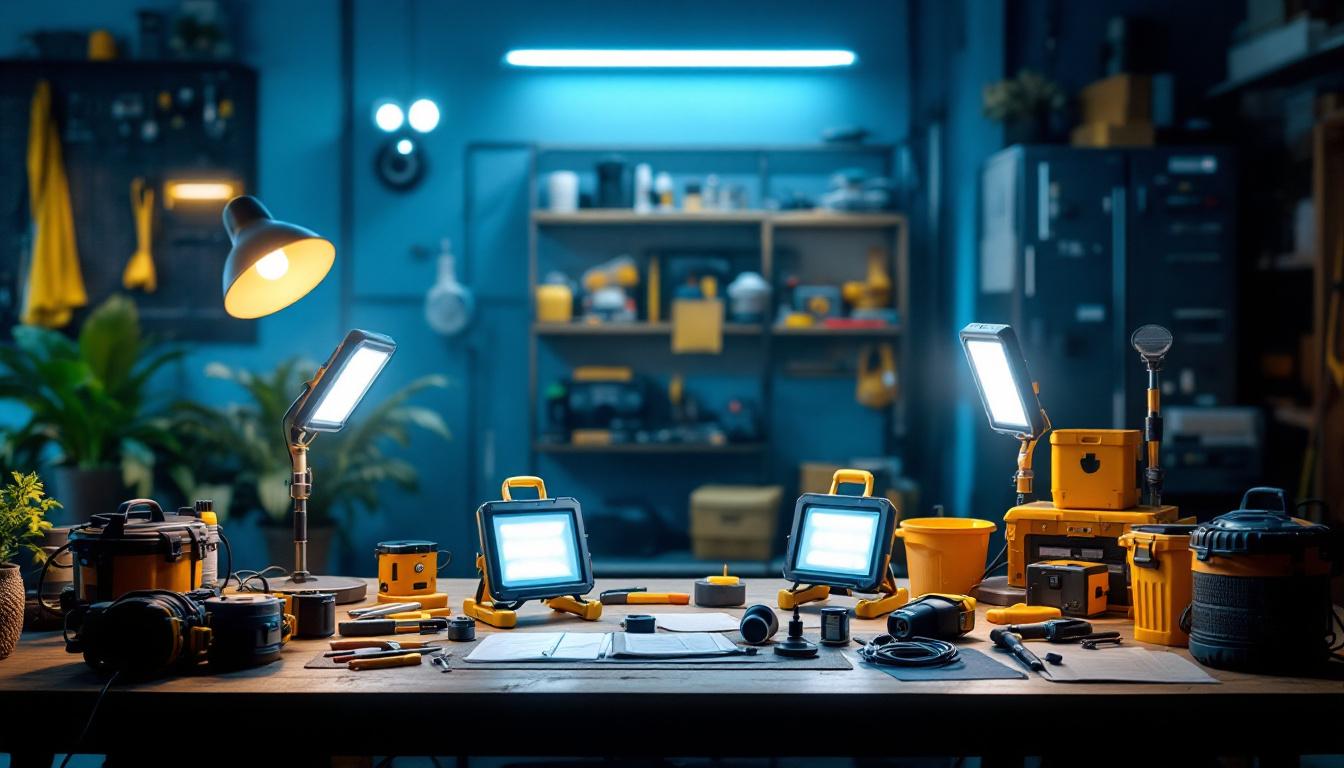
In the world of construction and renovation, lighting plays a pivotal role in enhancing both functionality and aesthetics. For lighting contractors, ensuring that every project meets the highest standards requires meticulous planning and execution. This comprehensive checklist serves as a guide for lighting contractors, helping them navigate the complexities of their projects with ease and confidence.
Before diving into any project, it is essential to clearly define its scope. This involves understanding the client’s needs, the type of lighting required, and the overall vision for the space. Engage in discussions with the client to gather insights into their preferences, budget constraints, and any specific requirements they may have.
Documenting these details not only helps in creating a tailored lighting design but also sets the foundation for the entire project. A well-defined scope minimizes misunderstandings and ensures that all parties are aligned from the outset. Additionally, it can be beneficial to create visual aids, such as mood boards or sketches, to help the client visualize the proposed lighting concepts. This collaborative approach fosters a sense of ownership and can lead to more fruitful discussions about the desired atmosphere and functionality of the space.
A thorough site assessment is crucial for identifying potential challenges and opportunities. During this phase, contractors should evaluate the existing electrical infrastructure, consider the layout of the space, and take note of any architectural features that may influence lighting design.
Additionally, assessing natural light sources is vital. Understanding how sunlight interacts with the space throughout the day can inform decisions on artificial lighting placement and intensity. This comprehensive evaluation will aid in creating a harmonious balance between natural and artificial light. Furthermore, it is important to consider the color temperature of the light fixtures in relation to the surfaces and furnishings within the space. Warmer tones can create a cozy ambiance, while cooler tones may enhance productivity in work environments. By taking these factors into account, the lighting design can be optimized to enhance the overall aesthetic and functionality of the space.
Establishing a realistic budget is a critical aspect of project planning. Lighting contractors should account for all potential costs, including materials, labor, and any unforeseen expenses that may arise. It is advisable to create a detailed budget breakdown to maintain clarity and transparency.
Resource allocation is equally important. Identify the necessary tools, equipment, and personnel required for the project. Ensuring that the right resources are in place will facilitate a smoother workflow and help avoid delays. Additionally, consider the timeline for procurement and installation of materials, as this can significantly impact the overall project schedule. Engaging with suppliers early on can lead to better pricing and availability, allowing for a more efficient execution of the project. Moreover, having contingency plans in place for resource shortages or delays can help mitigate risks and keep the project on track.
The selection of lighting fixtures can significantly impact the overall ambiance of a space. Contractors should consider various factors, including the purpose of the lighting, the style of the interior, and energy efficiency. Options range from recessed lighting and pendant fixtures to track lighting and wall sconces.
It is essential to strike a balance between functionality and aesthetics. For instance, in a kitchen, bright task lighting is necessary, whereas, in a living room, softer ambient lighting may be preferred. Consulting with the client on their preferences can guide the selection process.
A well-thought-out lighting layout enhances the functionality of a space while creating an inviting atmosphere. Contractors should consider the placement of fixtures to avoid shadows and ensure even light distribution. Utilizing lighting design software can aid in visualizing the layout and making necessary adjustments before installation.
Incorporating layers of light—ambient, task, and accent—can elevate the design. Each layer serves a unique purpose, contributing to the overall experience of the space. For example, accent lighting can highlight artwork or architectural features, adding depth and interest.
As technology continues to evolve, smart lighting solutions have become increasingly popular. These systems offer enhanced control over lighting settings, allowing for customization based on the time of day or specific activities. Integrating smart lighting can improve energy efficiency and provide added convenience for clients.
When designing the lighting plan, consider how smart technology can be seamlessly integrated. This may involve selecting compatible fixtures and ensuring the necessary infrastructure is in place for installation. Educating clients on the benefits of smart lighting can also enhance their overall satisfaction with the project.
Before installation begins, it is crucial to prepare the worksite. This involves clearing the area of any obstacles and ensuring that all necessary tools and materials are readily available. A clean and organized workspace not only promotes safety but also enhances efficiency during installation.
Additionally, contractors should communicate with other trades involved in the project, such as electricians and general contractors, to coordinate schedules and avoid potential conflicts. Establishing a clear timeline for installation can help keep the project on track.
Safety should always be a top priority during the installation phase. Contractors must adhere to all relevant safety regulations and guidelines to protect both themselves and their clients. This includes wearing appropriate personal protective equipment (PPE) and ensuring that the worksite is free from hazards.
Furthermore, it is essential to educate team members on safety practices and emergency procedures. Regular safety meetings can reinforce the importance of maintaining a safe work environment and foster a culture of safety among the crew.
As installation progresses, conducting quality checks at various stages is vital. This ensures that the work meets both industry standards and the client’s expectations. Inspecting fixtures for proper alignment, functionality, and aesthetic appeal can prevent issues from arising later in the project.
Encouraging team members to take pride in their work and uphold quality standards fosters a sense of accountability. Addressing any concerns promptly will contribute to a successful installation and enhance client satisfaction.
Once the installation is complete, conducting a thorough walkthrough with the client is essential. This provides an opportunity to showcase the completed work, explain the functionality of the lighting system, and address any questions or concerns the client may have.
During the walkthrough, contractors should encourage feedback and be open to suggestions. This not only demonstrates professionalism but also helps build a positive relationship with the client, paving the way for potential future projects.
Educating clients on the importance of regular maintenance is crucial for ensuring the longevity of their lighting systems. Providing clear guidelines on how to care for fixtures, replace bulbs, and troubleshoot common issues can empower clients to take an active role in maintaining their lighting.
Additionally, offering ongoing support and maintenance services can enhance client satisfaction and foster loyalty. Establishing a follow-up schedule to check in on the lighting system can further demonstrate commitment to quality service.
Feedback is an invaluable tool for continuous improvement. After project completion, contractors should actively seek client feedback to understand their experience and satisfaction level. This can be done through surveys, follow-up calls, or informal conversations.
Positive reviews and testimonials can significantly impact a contractor’s reputation and attract new clients. Encourage satisfied clients to share their experiences on social media or review platforms, as word-of-mouth referrals can be a powerful marketing tool.
The lighting industry is constantly evolving, with new technologies and design trends emerging regularly. Lighting contractors should prioritize staying informed about the latest advancements, whether through industry publications, trade shows, or online resources.
Engaging in professional development opportunities, such as workshops and certifications, can enhance skills and knowledge. This commitment to continuous learning not only benefits contractors personally but also translates into better service for clients.
Building a strong professional network can open doors to new opportunities and collaborations. Lighting contractors should seek to connect with other industry professionals, including architects, interior designers, and electricians. Networking can lead to referrals and partnerships that benefit all parties involved.
Participating in industry events and local trade associations can also provide valuable networking opportunities. Sharing insights and experiences with peers fosters a sense of community and can lead to innovative ideas and solutions.
After each project, taking the time to reflect on the process can yield valuable insights. Identifying what worked well and what could be improved can inform future projects and enhance overall efficiency. Adapting to feedback and embracing change is essential for growth in the competitive lighting industry.
Establishing a culture of reflection within the team encourages open communication and collaboration. By learning from each experience, contractors can continually refine their approach and deliver exceptional results for clients.
In the dynamic field of lighting contracting, having a comprehensive checklist can streamline the process and ensure successful project outcomes. From pre-project planning to post-installation considerations, each step plays a vital role in delivering high-quality lighting solutions. By focusing on clear communication, quality workmanship, and continuous improvement, lighting contractors can build lasting relationships with clients and establish a reputation for excellence in the industry.
Ultimately, the goal is to create spaces that not only meet functional needs but also inspire and delight. With the right approach and attention to detail, lighting contractors can illuminate their clients’ visions and bring them to life.
Ready to elevate your lighting projects to new heights? At LumenWholesale, we provide lighting contractors like you with the highest quality, spec-grade lighting products at prices that can’t be beaten. Say goodbye to middleman markups and hello to a vast selection of reliable lighting solutions that meet rigorous industry standards. With our commitment to affordability and convenience, you’ll enjoy free shipping on bulk orders, ensuring you get the premium lighting you need at the best value. Don’t compromise on quality or cost—Wholesale Lighting at the Best Value is just a click away. Partner with LumenWholesale today and light up your client’s world with confidence and ease.

Illuminate your outdoor spaces with confidence! Discover essential tips, types, and trends in exterior lighting to enhance your home’s curb appeal and functionality..

Discover essential tips and insights for lighting contractors on selecting and installing light fittings for ceiling fans.

Discover the essential checklist for lighting contractors to ensure seamless installation and maintenance of battery backup lights.

Discover the common pitfalls lighting contractors face when working with red and blue LED flood bulbs.